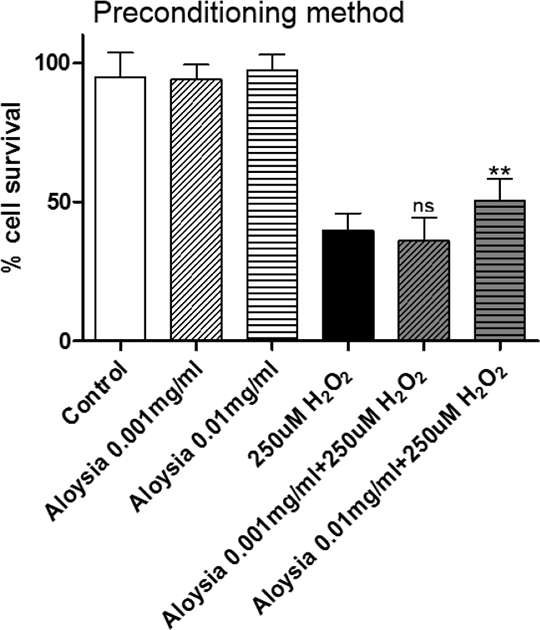Neuroprotective activity of Aloysia citriodora essential oil in H2O2-induced neurotoxicity in CAD catecholaminergic cells Background: Numerous plants have been used to treat symptoms observed in neurodegenerative diseases (1). Essential oils derived from Aloysia citriodora Palau, which has been used in traditional herbal medicine as calming and attention-enhancing agents, and aid to counter depression (2), were investigated for preconditioning and neuroprotection properties in neuronal CAD cell cultures. Objective: Essential oils derived from dried leaves of Aloysia citriodora Palau were analysed by GC-MS, and were investigated for preconditioning and neuroprotection properties in undifferentiated CAD cell cultures (DIV3) versus hydrogen peroxide (250 µM)-induced cytotoxicity (3). Results: Fig. 1 depicts % survival of undifferentiated CAD cells after 24 hr treatment with Aloysia oil (0.001 and 0.01 mg/ml (w/v)) followed by 24 hr treatment with 250 µM H2O2 (Aloysia-containing media removed before addition of H2O2 - Preconditioning method).Fig. 2 depicts %survival of undifferentiated CAD cells with 24 hr treatment with Aloysia oil (0.001 and 0.01 mg/ml w/v) followed by 24 hr treatment with 250 µM H2O2 (Aloysia-containing media not removed - Neuroprotection method) N=12 replicates, 3 independent cultures (** p<0.01; ***p<0.001 versus 250 µM H2O2, Dunnett\'s Multiple Comparison Test).  
Major components detected in the Aloysia citriodora oil from dried leaves included limonene (20.1%), geranial (6.3%), neral (3.7%), 1,8-cineole (9.2%), curcumene (6.3%), spathulenol (5.0%) and caryophyllene oxide (2.2%).0.01 and 0.001 mg/ml Aloysia citriodora essential oil significantly and fully protected CAD neuronal cells against H2O2 (250 µM) - induced cytotoxicity. Conclusion: Aloysia citriodora oil displays neuroprotective properties, consistent with its anti-oxidant characteristics (4). (1) Howes et al, Current Alzheimer Research 9:67,2012 (2) Catalan et al, The chemistry of the genus Lippia (Verbenaceae) first ed:127,2002 (3) Freshney, Culture of Animal Cells 6th ed: 373,2011 (4) Abuhamdah R. et al, Proceedings of the British Pharmacological Society 10:144, 2012
|



